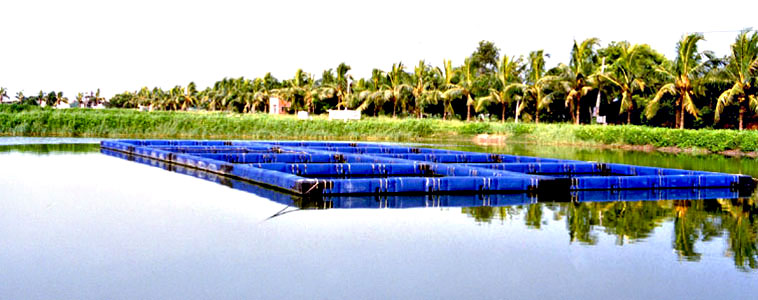|
| |
Inland
Cage |
| |
| Specification
: 5.25*5.25*2.0 meters |
Capacity
: 1.2 ~ 1.5 ton / cage |
8
sets / 20 feet container |
| Nylon
knotless net with mesh of 1 cm |
|
| |
Applications
and Characteristics: |
|
|
|
|
|
- Fry taming and Conditioning
|
|
|
| |
|
- Easy accessible for fry taming and condition.
- More efficient in ponds utilization.
- A variety of fishes can be stocked in
different cages to be raised in the same pond so as to minimize the
need to occupy different ponds.
|
|
- Polyculture
|
|
|
|
- In different cages of the same pond, one
can raise fishes with different feeding habits (carnivores, herbivores
or omnivores) without the fear of experiencing mortalities caused by
cannibalistic behavior among the fishes.
- The farmer's utilization of the working
capital can be increased by raising fish species with different grow
out period (long vs. short) in the same pond.
- A balanced pond water environment can
be established and maintained by properly growing different species
of fishes in the same pond.
- Also applicable for the culture of fish
in the pond and oysters in the cage, or raise the shrimp in the pond
and fish in the cage.
|
|
|
|
|
|
|
|
|
|
|
|
|
|
 |
|
- Increase the Culture Quality
|
|
| |
|
- For the live fish market, marketable size
fish can be harvested on cage at a time to increase the survival rates
of the live fishes during transport.
- Improve the quality of the harvest fish,
prior to harvest, fishes are normally not fed. Under normal pond condition,
starved fishes will tend to go to the pond bottom to feed on mud or
even detritus something introducing an off muddy flavor to the body.
This would not be possible under cage
conditions.
- More efficient FCRs to reduce feed cost.
Energy (feed) can be more efficiently converted to meat due to the limited
space of the cage.
|
|
| |
|
|
|
|
|
| |
|
 |
|
- More convenient in aquaculture
operation
|
|
|
|
|
|
|
|
- Save time and labor. Two persons can
harvest the fish inside a cage without difficulty.
- Grading the size of the fishes efficiently.
By using the correct mesh net and properly manipulation the net during
feeding, grading the fishes can be easily undertaken.
- When the fishes inside the pond are not
yet of harvestable size, one can very quick start a new crop by raising
the same or different species inside a cage.
- Easy to move fish from one pond to another.
|
|
|
|
|
|
|
|
|
|
|
|
|
|
|
- Easy for disease treatment
|
|
|
|
|
 |
|
| |
|
- Sick or diseased fishes can be segregated
inside a floating cage for observation or treatment.
- By installing a tarpaulin (precut and
approximating the dimensions of the net) inside the net, one can isolate
pond water inside the cage and apply chemicals for treatment of diseases.
Volume of chemical used in drastically reduced due to the reduce volume
of water.
|
|
- Easy in recording data
|
|
|
|
|
|
| |
|
- Feeding rate.
- Growth
rate.
- Observations
for the development of diseases.
|
|
|
|
|
|
|
|
|
|
|
|
|
|
|
|
|
|






